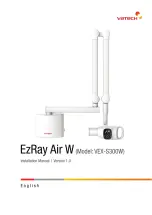
1062788
BiPAP Vision Service Manual © Respironics, Inc.
3-1
Chapter 3. Theory of Operation
The BiPAP Vision is a microprocessor-controlled, positive pressure ventilatory
assist system. The system’s integral air intake filter draws in ambient air which
is then pressurized by the system’s centrifugal blower assembly. In the blower
discharge airway, the in-line flow restrictor (ILFR) valve and pressure
regulation valve (PRV) regulate total flow and pressure from the blower. The
oxygen module adds a controlled source of supplemental oxygen, up to 100%,
to the patient.
To ensure that the device delivers gas according to settings, the pressure
control (PC) board continuously monitors airflow module (AFM) readings for
total gas flow, temperature, generated pressure, and patient circuit pressure.
The PC board transmits process data to the main control (MC) board, which
then provides overall control of the BiPAP Vision and sends instructions to the
PC board regarding required ILFR-PRV valve stem positions and blower speed.
The unique design and operation of the device makes it suitable for mask
applications. Designed with the BiPAP Auto-Trak Sensitivity feature that
automatically adjusts to changing circuit conditions, the device can ensure
optimum patient-ventilator synchronicity despite changes in breathing patterns
and circuit leaks. (Refer to the BiPAP Vision
Clinical Manual
.)
A liquid crystal display (LCD) screen is mounted on the front enclosure. The
LCD and the display control (DC) board provide the primary user interface to
the BiPAP Vision. The user interface displays data, provides controls, and
visual and audible alarm indicators. The user uses the touch pad and rotary
encoder to provide input, and the display confirms the input. Display
information varies according to the state of the ventilator and operations being
performed.
The BiPAP Vision incorporates these safety features and self-diagnostic
systems:
•
The device automatically checks internal system functions at startup
and periodically throughout normal operation.
•
Audible and visual alarms occur in the event of principal subsystem
failures.
•
Audible and visual patient alarms occur during normal operation.
















































